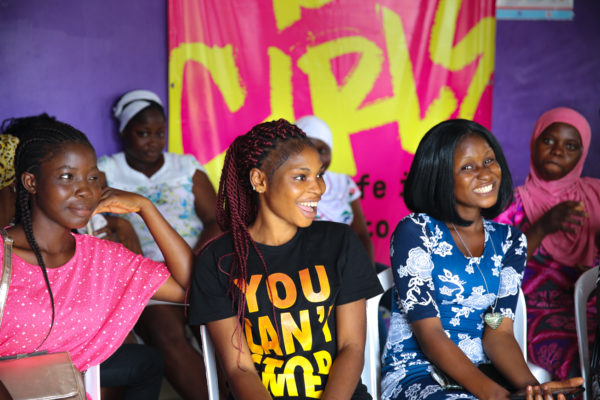By Meghan Cutherell, PSI/A360 Senior Program Manager and Kasey Henderson, PSI/A360 Senior Associate Communications Manager
Catalytic impact grows from a mindset shift.
With the September 2020 conclusion of Adolescents 360 – the first phase of PSI’s flagship adolescent sexual and reproductive health (ASRH) project – we’re taking another look at what we’ve learned over the past five years through our most recent publication, Learning from the Adolescents 360 project in Tanzania, Ethiopia, and Nigeria. As we take these lessons into A360 – Adolescents 360’s follow-on project – we’re committing to engaging the global ASRH community of practice to address the persistent barriers that inhibit adolescents from pursuing their holistic aspirations.
Here are five of our key takeaways from the past five years of design and implementation for A360:
1. Lead with Girls Aspirations to Establish Contraceptive Relevance, and Prioritize Multi-Sectoral Programming
Adolescence is a vital period for defining aspirations and life goals related to education, livelihood, and family. During A360’s formative research, girls conveyed the expansive dreams they had for their lives that included, but extended beyond, motherhood. Even when they had sex occasionally, adolescents in A360’s target geographies often did not identify as sexually active for a variety of reasons. Since traditional SRH approaches lead with sexual activity as a precursor to contraceptive use, and ignored the central role of motherhood in girls’ aspirations, many did not perceive use of contraceptives as relevant to them.
So what?
A360’s aspirational program components were critical to the project’s success at engaging adolescent girls and providing them with relevant, effective services. Yet, there is clear value in expanding these components to meaningfully support girls to pursue their economic and life goals.
2. Program for an Improved Enabling Environment to Pursue Gender-Transformative Impact
Support from adolescent girls’ key influencers is central to fostering an enabling environment for their contraceptive use. A360’s formative research validated the importance of engaging key influencers and clarified a hierarchy of influence that different stakeholders had in girls’ lives – for example in Ethiopia, married girls identified male partners and mothers-in-law as key influencers but noted that when male partners were supportive, resistance from mothers-in-law was dramatically reduced. In A360’s formative research the project also found that the same messages that resonated with adolescent girls around pursuing a healthy and prosperous future also resonated with others in their communities.
So what?
Programming for an improved enabling environment, and specifically involvement of girls’ key influencers and communities, is critical to transformation of inequitable norms that limit girls’ SRH and agency. A360 engaged in strategies that targeted all levels of the enabling environment but recognized the need for a more consistent and rigorous approach that could be truly transformative.
3. Supporting Contraceptive Continuation is Critical and Must be Tailored to the Unique Experiences of Adolescent Girls
A360’s early implementation phase (2018) was characterized by an overemphasis on contraceptive uptake as the primary metric of program success and a lack of focus on support for adolescent girls’ continued contraceptive use. However, A360’s analysis of performance data, external evaluation results at midline, and tracing of small cohorts of girls in Ethiopia and Nigeria all reinforced the need to consider factors beyond contraceptive uptake to promote broader impact. As a result, the project tested a series of small adaptations to support adolescent girls who adopted a contraceptive method through A360.
So what?
Contraceptive continuation among adolescents remains a challenge for the global ASRH community of practice. A360’s learning reinforces a need to find strategies or a package of services that respond to adolescent girls’ unique patterns of use – and measurement approaches which are relevant and effective at understanding whether girls are able to continue to use contraception in line with their fertility intentions and aspirations.
4. Maintain a Commitment to Learning and Continue to Iterate Beyond Design
Global evidence is clear – interventions benefit from ongoing continuous quality improvement during implementation to refine and strengthen them in response to real world contexts. Evidence collected in a narrow, relatively optimal set of circumstances, such as design, may not apply in the same way in every implementation context. A360 has always embraced the need for iterative, learning-based implementation to identify areas where the project could be strengthened to respond to the needs of adolescent girls and local health system actors, while maintaining fidelity to core foundational elements of its interventions. The project designed monitoring and field research systems that allowed for rapid review of qualitative and quantitative data to inform continual adaptation with a multi-disciplinary group of stakeholders.
A360 found that adaptive implementation allowed the project to continue using a ‘design mindset’ as it moved from its formative research phases into implementation.
So what?
Continuous quality program improvement through adaptive implementation critically supported A360 to retain its user centered focus during implementation and created a culture of curiosity and iteration that also influenced the project’s governance and global structures.
5. Design with the End in Mind: Pursue Sustainable Scale from the Outset
Throughout its initial investment, A360 implemented its intervention models through existing public health structures and in partnership with government actors. After completing a year and a half of implementation, strengthening its intervention models through adaptive implementation, and generating preliminary evidence on its intervention effectiveness, A360 intensified its focus on sustainability. This focus acknowledged that the primary avenue for sustainability for the project’s intervention models would be through government integration.
So what?
A360’s learning highlights valuable questions related to program sustainability. Designing for end users must be balanced with design for the systems and structures through which an intervention will be implemented. However, at what point can programs adequately prove their interventions are effective enough to justify pursuing sustainable scale up, particularly through government integration?
These lessons (and questions) have guided A360 in the development of its technical strategy under its second phase. Yet, the need for learning and iteration has not stopped. A360 continues to grow in its understanding of what it takes to support sustained, transformative, holistic change for adolescent girls and commits to openness and transparency regarding successes and failures during its next project phase.






